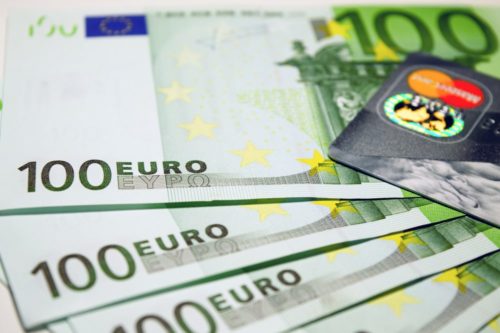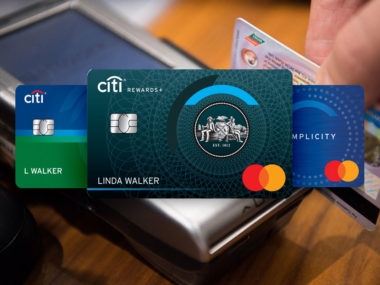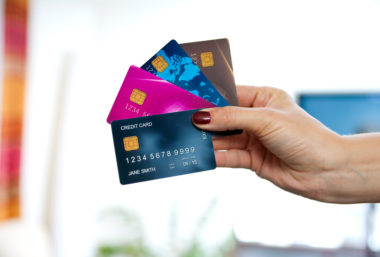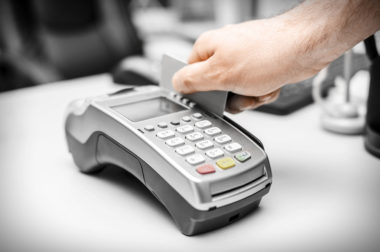Credit cards are ingrained in the American culture. They make up the majority of transactions, and credit card offers seem to appear every day in the mail or as commercials during your favorite shows. But what about the rest of the world? Are they as enthralled by paying with plastic as we are? Let’s compare the U.S. with countries across Europe and Asia to get a better sense of how the world charges.
Table of Contents
Europe
The first major, obvious difference between the U.S. and Europe is the chip-and-PIN card. While the EMV card is a recent development in the U.S., it’s old hat for Europeans. For the most part, credit cards in America are verified with the chip-and-signature combination. Here, it’s mostly debit cards that use a PIN, while both types of cards now use PINs in Europe. With 781 million cards issued in the E.U., each person has an average of 1.6 payment cards for the population of about 510 million.
Compared to 2017, the number of non-cash payments in the European area increased by 7.9% in 2018. Additionally, according to the European Central Bank, card payments accounted for 46% of the total number of non-cash payments in the euro area.
In total, in 2018, the E.U. saw about 90.7 billion credit transactions, resulting in €1.8 trillion (about $1.9 trillion) credit card expenditures, which equals about €44 ($47.66) per transaction. Credit and debit expenditures combined added up to €2.6 trillion from 53 billion transactions.
The UK
As of January 2020, the United Kingdom spent a total of £17.2 billion with credit cards, which amounts to a little over $18.6 billion. Additionally, there are 65 million U.K. residents who have active credit cards.
The average percentage of credit card debt was 3%, down from 8% in 2018. However, credit card use is growing with the popularity of contactless card transactions, up 16% more than January 2019.
Of the E.U. 28, eight of the countries have a greater proportion of non-cash transactions, including credit and debit cards.
For the most part, Europe uses cash. Travel expert Rick Steves suggests relying mostly on cash while in Europe, but you can still use your credit card overseas for convenience. Be warned, however, that you will be charged a transaction fee, which differs from lender to lender. Also, if you are not in a large city, credit cards may not be accepted. Some vendors may also set minimums, such as requiring the purchase to be at least €20 before you can use a card to pay.
Asia
Let’s look at a few major examples from this Asia, including some that are nearly polar opposites: Japan, Korea, and Singapore.
Japan
According to the Japan Consumer Credit Association, card transactions have doubled in the past decade, reaching about 66.7 trillion yen in 2018. Each Japanese adult owns an average of 2.7 cards. ?
However, the amount of yen notes and coins in circulation has doubled in 20 years, and cash comprised 80% of transactions in 2014. About 70% of consumers used cash for transactions in 2016, while digital payments came in second, at 28.2%.
Interestingly, many Japanese prefer a unique way of paying with cash: the konbini. Konbini, the generic term for a convenience store, allows users to order an item online, which is then shipped to the konbini, and then pay in cash at the store when picking up their purchase.
Similar to Europe, visitors are safer using cash for travel expenses and purchases at smaller stores in Japan. Shrines, often popular tourist destinations, usually only accept cash. Again, check with your bank for foreign transaction fees.
South Korea
Almost exactly opposite of Japan, only consumers only made 20% of transactions in South Korea with cash as of March 2016. The Bank of Korea aims to go completely coinless in 2020.
Korea, much like Europe with the chip-and-pin card, surged ahead in technology in 2004 with t-money, a type of e-commerce for transportation. T-money lives on a chip, which can fit in credit or debit cards, or on a SIM chip in a phone.
Korena consumers used t-money in 43 million transactions daily by the end of 2014, with more than 15 million users in Seoul. It’s used in most convenience stores, echoing the trend from Japan, as well as in some retail shops and restaurants.
With the success of t-money and its integration into credit cards, other companies, including Samsung, are developing their own mobile payment methods to compete, taking even more of the market share away from cash.
To promote the use of cards and t-money, Korea is removing coins from circulation, with change coming in the form of larger denominations of coins mixed with converting the “change” to t-money. Yet, South Korea is still spending 50 billion won ($44 million) per year on minting coins .
At the end of 2016, Koreans had about $1,200 in outstanding credit card debt per capita.
The United States
How does this compare to America’s spending habits? Consumers made 174.2 billion non-cash payments in 2018, which were valued at $97.08 trillion, far outpacing the European Union’s figures. On average, the average American household owes $6,354 in credit card debt. According to USA Today, Alaska has the highest credit card balance at $8,515, while Iowa has the lowest balance at $5,155.
While Europe adopted the EMV chip in the ‘90s, it has only been within the past few years that America’s credit cards saw the chip embedded. Even with the chip, we still use a signature instead of a PIN.
Like Korea, Americans have adopted contactless payment methods — from RFID chips in credit cards to Apple Pay — but they’re not nearly as widespread as Korea’s t-money.
With the rise of contactless payment methods, many Americans are no longer carrying cash when they go out. If they do, 76% say they carry less than $50, according to CNBC. However, only 26% of Americans preferred to use cash as a payment. The Federal Reserve Bank of San Francisco reports that debit cards were the most used instrument at 28% while credit cards account for 23% of payments.
Is it better to use a debit or credit card abroad, as you would in the U.S.? The answer depends on where you are going. Cash will always be a safe bet, but it could be more convenient to have a card instead. Do research before you travel, and you should always have a way to pay.
Image source: https://www.pexels.com/





